It was not the soldiers of the Empire, but the rebels who built the Death Star. She was ready to destroy the invading Empire and any other enemy. But before it was used, it exploded and its creator died. It was 1820.
When the slaves in Haiti, rebelling against France, chased Napoleon's army away, they decided to protect themselves against their return. One of the rebel leaders, Henri Christophe, commissioned the erection of an imposing fortress in 1805, towering over the north of the country like a star.
On the one hand, it was a symbol of Haitian aspirations, progress and democracy. "As you see a star in the sky [...], so the citadel symbolizes our highest ideals," said the leaders of the Haitian revolution. On the other hand, from a military point of view, it was supposed to stop a possible further invasion of the French Empire and secure the connection between the main cities of the island.
But soon the originator himself, Henri Christophe, betrayed the republican ideals and switched to the "dark side of the force", establishing a strong arm rule. And he started very modestly - in a place well known to Poles.
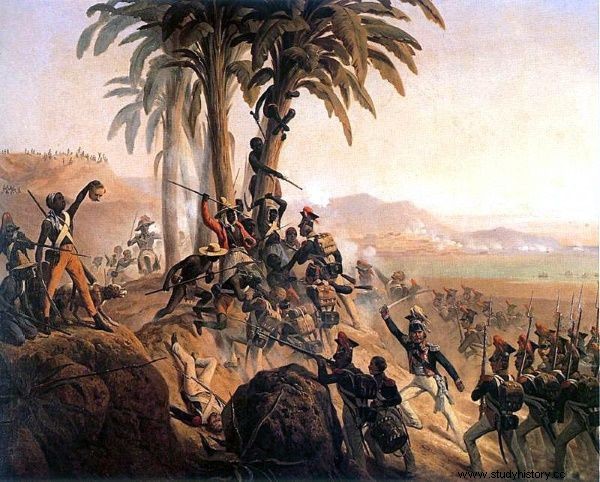
The Haitians spared no effort to free their island from the French occupiers ... Picture by Jan Suchodolski (source:public domain).
Dobosz at Savannah
“Pulaski shouted forward and we, two hundred horses behind him, galloped to the ground until the ground shook! " - recalled Maciej Rogowski, a participant in the Battle of Savannah in 1779. The Americans fighting for independence and their allies fought there with British troops. Unfortunately, General Kazimierz Pułaski and his cavalrymen were caught in the crossfire. It was a massacre.
“The cannonball broke his leg, and blood is puffing from his chest as well, probably from another shot. I got down on my knees and started picking him up, pronouncing in a dying voice Jesus, Mary, Joseph . I did not hear anything more, I did not see anything, because at the same moment, a rifle ball slipped on my skull, the blood flooded my eyes and I passed out completely "- said Rogowski.

In this battle, on the side of the Americans, also "colored" Caribbean volunteers from French colonies (the so-called Chasseurs-Volontaires de Saint-Domingue ). Among them, the son of a slave Henri Christophe from Granada. He was only twelve at the time, a drummer.
The boy did not even suspect that the Poles with whom he fought side by side in America in 1779, in a quarter of a century, in Napoleonic times, would be fighting against his people in the Caribbean. And the Black Madonna, which was worn on scapulars by Pulaski's comrades (including the former Bar Confederates), will also go to Haiti with Napoleon's Polish legionnaires (and will be adopted there in the local water cult).
In 1805, when Henri Christophe decided to build his fortress in Haiti, he was already a different man than in 1779. He had acts of heroism and war crimes behind him in Haiti. He served the cause of freedom, but also dreamed of more and more power. Jedi Henri became Darth Christoph. In 1811 he was crowned king.
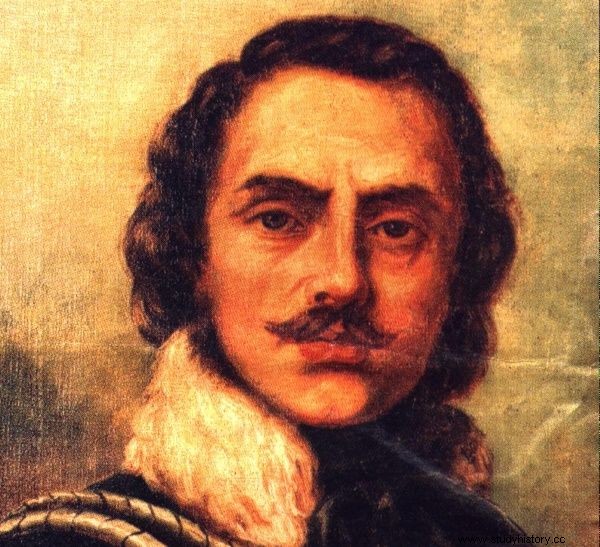
Kazimierz Pulaski had no idea that his army was ... the future king of Haiti! (source:public domain).
"Freedom" under the weight of the cannons
The shadow of France, a mighty overseas empire that could once again claim "its", still loomed over Haiti. And over King Henry I also hung the threat of an attack by competitors to power. Therefore, he forced his subjects to make inhuman efforts to build his dream fortress.
The Laferriere Citadel was built near the town of Milot, 20 km from Cap-Hatien. Christophe hired Western architects, but the idea was his - a former stonemason. A fortress was erected on the top of a 900-meter mountain, known as the Bishop's Cap. She stood on a solid rock. The walls were 40 meters high. They were up to nine meters thick.
Years later it was written that this seemed absurd - that it was like building a Gibraltar fortification on top of Mont Blanc to defend the Atlantic coast.
Tens of thousands of people worked on the construction site, some sources even say 200,000. The king did not even forgive the women, the elderly and children - they also had to work off theirs. He punished his disobedience with death. This was the "freedom" won by the rebels. To this day, it is not known how many victims were involved in the construction:two thousand, five, ten, twenty? ...
This article has more than one page. Please select another one below to continue reading.Attention! You are not on the first page of the article. If you want to read from the beginning click here.
The death star will explode
After a dozen or so years, the citadel was almost ready. One of the largest structures of this type in the Western Hemisphere looked like a ship pushing through the hills. Like a ship with a bow against which foreign missiles will crash. It could accommodate five or ten thousand defenders. She had supplies of water and food to withstand any attack.
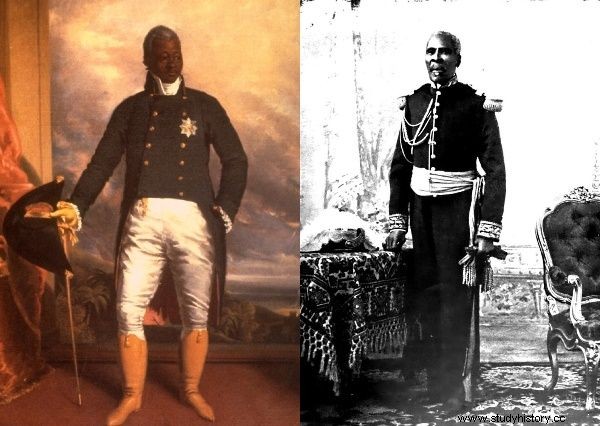
King Henri I stands proudly in front of the painter…
The walls were haunted by artillery of various caliber, 360 pieces. The French cannons bore the monograms of the Bourbons and Napoleon. Stacks of missiles waited nearby - several tens of thousands. And suddenly, in 1818, an explosion shook the almost finished "death star"! It was the gunpowder magazine that blew up, and in it Prince Noel, the king's brother-in-law and the commander of the fortress.
Was it an accident, a plot, a curse, an act of madness? It is not known. The king ordered the destruction to be repaired, but - as it turned out - the cannons of the Haitian fortress were never supposed to fire at the enemy ...
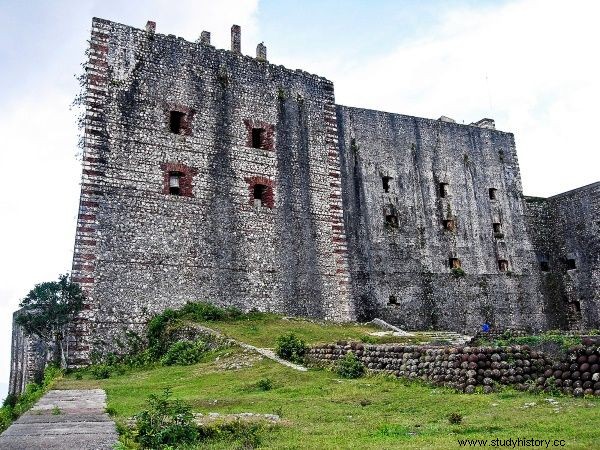
Haitian death star pictured by Rémi Kaupp (license CC BY-SA 3.0)…
Rebellion against a former rebel
In 1820, there was a rebellion against the weakening, ailing king. Henry I realized his days were numbered and he even had his own guards against him. He shut himself up in the Sans-Souci Palace - a kind of copy of Versailles near Paris, which he erected under the citadel. There he shot himself a silver bullet in the head as if he considered himself some kind of outworldly being.
However, this extravagance was not enough - there had to be a gulf of his body somewhere. Some locals say that she was buried in the citadel itself, under a large boulder. Many have tried to find the tomb - believing there were treasures in it - but to no avail. On the other hand, a branchy tree grows under the palace to this day, supposedly planted on the day of the king's death.
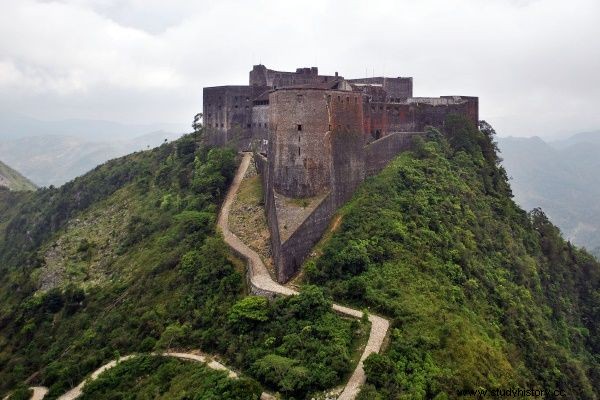
And in a photo taken from the deck of an X-wing… pfu !, a US military fighter plane (source:public domain).
Sans-Souci was heavily damaged by the 1842 earthquake and turned into a ruin. The citadel, restored under the auspices of UNESCO, still demonstrates the ambition and madness of the slave turned king. Jedi Knight turned tyrant. A visionary who, at the cost of his subjects' blood, developed a super weapon, but never even used it.
If the creators of "Star Wars" like to refer to history so much (ancient Rome, Germany, World War II), maybe they would look for inspiration on the island an hour and a half flight from Miami? J.J. Abrams, Lucasfilm and Disney - go this way!
***
Polish hunters of the living dead, disgusting rituals of Caribbean shamans and crimes committed at distinguished European courts. Adam Węgłowski travels continents in search of stories that will keep you awake at night. Only now you can buy the new book "Historical Curiosities" 30% cheaper!

Not only about zombies. But only a true story. Visit the bookstore!
Sources:
The article is based on the literature and materials collected by the author during the work on the book "The Living Dead. The real zombie story ” . Find out more by clicking HERE . Selected bibliographic items below:
- Roseline Ng Cheong-Lum, Leslie Jermyn, Cultures of the world:Haiti , Marshall Cavendish, 2005.
- Leonard Chodźko, The life of Kazimierz in Pułaż Pulaski, starost of Zzuleniec, marshal of the Łomża Confederacy, little Polish regiment, general in the American army, 1748–1779 , Publishing House "Mrówki", 1869.
- Laurent Dubois, Haiti:The Aftershocks of History , Picador, 2012.
- Michael R. Hall, Historical Dictionary of Haiti , Scarecrow Press, 2012.
- Tadeusz Łepkowski, Haiti. The beginnings of the State and the Nation , PWN, 1964.
